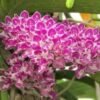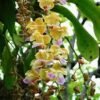**Biological Characteristics and Morphology of the Da Châu Orchid (Rhynchostylis gigantea)**

The Da Châu orchid, scientifically known as *Rhynchostylis gigantea*, is a remarkable plant native to Southeast Asia, particularly cherished for its unique beauty and captivating aroma. This orchid, commonly called the Foxtail orchid, has gained widespread recognition and popularity due to its unique floral structure, robust form, and resilience. By understanding the biological characteristics and morphology of the Da Châu orchid, we gain insight into its adaptive strategies, survival mechanisms, and the intricacies that make it so captivating to orchid enthusiasts around the world.
### 1. Botanical Classification and General Characteristics
The Da Châu orchid belongs to the Orchidaceae family, one of the largest and most diverse plant families, with *Rhynchostylis gigantea* being a notable member of the subtribe Vandae. This subtribe is characterized by its epiphytic lifestyle, meaning that these orchids primarily grow on trees and other plants, using their host for support without extracting nutrients directly from them. Instead, the Da Châu orchid derives nourishment from the surrounding air, moisture, and organic matter.
This orchid’s popularity stems from several defining traits: it has long-lasting blooms, a delightful fragrance, and a robust growth habit that makes it easy to maintain, even for beginner orchid enthusiasts. Additionally, it is a resilient plant that can adapt to various environments, allowing it to thrive in both natural and cultivated settings.
### 2. Root Structure and Growth Habits
The root system of the Da Châu orchid plays a crucial role in its survival, particularly in the dense, humid forests of Southeast Asia. This orchid has thick, fleshy roots that are covered in a spongy tissue known as velamen. Velamen serves multiple purposes: it helps the plant absorb water and nutrients from the air, anchors the plant firmly to tree trunks or branches, and protects the inner root tissue from desiccation (drying out) when moisture is scarce. The velamen also gives the roots a silvery-white appearance when dry and turns green when wet, as it allows water to penetrate to the root interior.
Since the Da Châu orchid is epiphytic, its roots grow in an outward manner, seeking air and moisture rather than soil. This adaptation helps the orchid survive in environments where water is abundant but unevenly distributed, such as rainforests with alternating wet and dry periods. The ability of these roots to cling securely to tree bark enables the orchid to remain stable during heavy rains or strong winds, providing a survival advantage in its native habitat.
### 3. Leaf Structure and Adaptations
The leaves of the Da Châu orchid are another defining feature. They are long, thick, and leathery, typically growing in an alternating arrangement along the stem. This arrangement allows each leaf to receive maximum sunlight, which is essential for photosynthesis in the dense, often shaded forests where the orchid naturally grows. The thick, leathery texture of the leaves helps the orchid retain water, a vital adaptation for periods when water is less available.
Da Châu orchid leaves are typically dark green, which aids in efficient photosynthesis, and their slightly waxy texture provides some resistance to water loss and deters herbivores. Additionally, the leaves have a tough cuticle that reduces evaporation, a beneficial trait in humid but occasionally drought-prone environments. These adaptations help the orchid conserve water, making it resilient in both high-humidity and more arid conditions.
### 4. Flower Structure and Morphology
The Da Châu orchid is best known for its stunning flowers, which emerge from long, pendulous flower spikes that can reach up to 40 cm in length. Each spike, or inflorescence, holds numerous small flowers densely packed along the spike, creating a cascading effect that resembles a foxtail, hence its nickname, the Foxtail orchid. These flower spikes usually grow from the base of the leaves and hang down, making a dramatic display when in full bloom.
Each individual flower of the Da Châu orchid is about 1-2 cm in diameter, with a distinctive color pattern that varies between white, pink, and purple shades. The flowers are typically round and exhibit a characteristic lip shape, with the lip (labellum) often being larger and more colorful than the other floral parts. This lip serves as a landing platform for pollinators and is thought to play a role in attracting insects to aid in pollination. The vibrant colors and unique fragrance of the Da Châu orchid are highly appealing to insects, which assist in the plant’s reproductive process.
The flowers are typically long-lasting, remaining open for several weeks, which is advantageous for ensuring successful pollination. Furthermore, the flowers of the Da Châu orchid are highly fragrant, emitting a sweet, spicy aroma that is particularly noticeable during the morning hours. This fragrance is another adaptation aimed at attracting pollinators, particularly bees and other insects sensitive to scent. This aroma, coupled with the orchid’s striking appearance, makes it a highly sought-after plant among orchid enthusiasts.
### 5. Reproductive Characteristics and Pollination
The Da Châu orchid reproduces both sexually, through pollination, and asexually, through offshoots or “keikis” (baby plants). Sexual reproduction occurs when pollinators, such as bees, are attracted by the orchid’s fragrance and colorful flowers. As the pollinator lands on the flower, it brushes against the anther, picking up pollen that it subsequently transfers to another flower, facilitating cross-pollination.
Each flower produces a large number of tiny, dust-like seeds encased in a capsule. Once the seeds are mature, the capsule opens, allowing the wind to disperse them into the surrounding environment. These seeds are incredibly light and can travel long distances, ensuring that some may land in suitable growing locations. However, because orchid seeds lack nutrient stores, they require specific fungi, known as mycorrhizal fungi, to germinate and grow. This symbiotic relationship allows the orchid to obtain nutrients from the fungi, essential for successful seedling establishment.
In addition to seed propagation, the Da Châu orchid can produce vegetative offshoots. These offshoots, or keikis, grow from the base of the plant and develop their own root systems. Over time, they can be separated from the parent plant to grow independently, making them a popular choice for orchid propagation among growers.
### 6. Growth Cycle and Blooming Season
The growth cycle of the Da Châu orchid is closely tied to the seasonal changes of its native tropical environment. Typically, the orchid undergoes a period of active growth during the rainy season, when moisture and humidity are abundant. During this time, the plant produces new leaves and root growth is vigorous, helping it to establish a strong foundation for flowering.
The blooming season for the Da Châu orchid generally occurs in the cooler, dry months, which may vary depending on its location. In Southeast Asia, the orchid usually blooms between December and February, aligning with the Lunar New Year celebrations, making it a prized ornamental plant during this period. The dry season provides optimal conditions for flower development, as the reduced rainfall prevents damage to the delicate flower spikes.
Once the blooming season is over, the orchid enters a period of dormancy, where growth slows down, allowing the plant to conserve energy. During dormancy, the orchid requires less water and fertilizer, and it is essential for the overall health and longevity of the plant. Proper care during dormancy ensures that the Da Châu orchid will have the resources needed to produce vibrant blooms in the following season.
### 7. Environmental Preferences and Cultivation Requirements
The Da Châu orchid thrives in environments that mimic its native tropical habitat. It requires high humidity levels, ideally around 60-80%, and good air circulation to prevent fungal diseases. This orchid prefers bright, indirect sunlight, as excessive direct sunlight can scorch its leaves. In natural settings, it grows under the canopy of trees, receiving filtered sunlight, so recreating these conditions is key to successful cultivation.
Temperature is also an important factor for the Da Châu orchid’s growth. It prefers a warm environment, with ideal daytime temperatures between 20-30°C (68-86°F) and nighttime temperatures that do not drop below 15°C (59°F). It can tolerate brief temperature fluctuations but will thrive best when kept in a stable environment with minimal changes.
In cultivation, the Da Châu orchid is typically grown mounted on a tree slab or in a basket with minimal growing media, allowing its roots to hang freely and absorb moisture from the air. This setup replicates its natural growing conditions, supporting healthy root development and reducing the risk of root rot. Frequent misting or watering is required to keep the roots hydrated, especially during the active growth season.
### 8. Threats and Conservation Status
While the Da Châu orchid is a robust and adaptable plant, it faces several threats in its native habitat, primarily due to habitat destruction and over-collection. Deforestation and land clearing for agriculture and urban development have led to the loss of many natural orchid habitats across Southeast Asia. Additionally, the high demand for wild-collected orchids in the horticultural trade has contributed to the decline of wild populations.
In response to these threats, conservation efforts have been implemented to protect native orchid species, including *Rhynchostylis gigantea*. International trade regulations, such as those under the Convention on International Trade in Endangered Species (CITES), restrict the collection and export of wild orchids, encouraging the cultivation of orchids from sustainable sources. Botanical gardens and orchid nurseries have also played a crucial role in propagating the Da Châu orchid through tissue culture and seed propagation, ensuring that this species remains available to enthusiasts while reducing pressure on wild populations.
### 9. Conclusion: The Beauty and Resilience of the Da Châu Orchid
The Da Châu orchid’s fascinating biological characteristics and unique morphology make it a treasured species in the world of orchids. From its robust root system and water-retent
ive leaves to its captivating flowers and distinctive fragrance, every aspect of this orchid reflects an evolutionary adaptation to its tropical environment. The combination of its aesthetic appeal and relative ease of cultivation has led to its widespread popularity among horticulturists and plant lovers alike.
By understanding and respecting the biological needs of the Da Châu orchid, growers can enjoy the beauty of this remarkable plant while supporting conservation efforts that protect its wild populations. Through sustainable practices and a deeper appreciation for its ecological significance, the Da Châu orchid will continue to thrive and inspire for generations to come.

